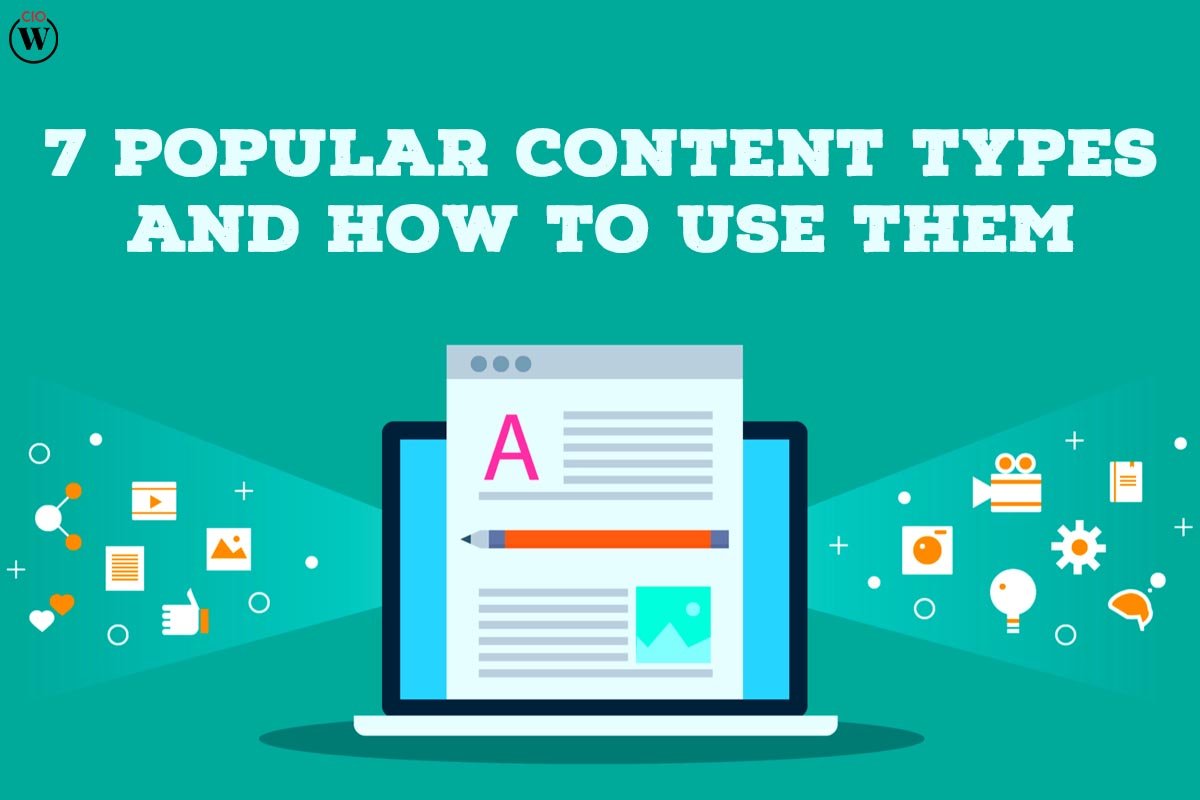Content marketing is a key aspect of any internet marketing plan. It enables you to reach out to your consumers and raise brand recognition. It may also assist create leads, enhancing revenue, and increasing conversions.
But, it’s crucial to bear in mind that the sort of material you employ plays a significant part when it comes to raising engagement rates – this means that various forms of Popular Content Types will perform better depending on your audience and their preferences.
Here are 7 Popular Content Types and How to Use them;
1. Video clips
One of the most interesting and successful methods to interact with your audience is via video. These may be used to answer frequently asked questions, illustrate how something works, or promote your goods or services.

Videos Popular Content Types are also excellent for demonstrating your skills via lessons and case studies. You may give extra value to individuals who seek more knowledge on certain themes by making a video series (a collection of short movies varying in length) about different topics relating to your business—and perhaps entice them to purchase other goods or services you provide as well.
While generating films, you may want to consider utilizing an online application like VEED video editor since they make it simple for anybody who understands how to use a computer keyboard but not much more!
2. Webinars and podcasts
Webinars and podcasts Popular Content Types are excellent for presenting knowledge in a digestible manner to your audience. They’re also quite cheap to make since you just need one or two cameras, a good microphone, and dependable software.
You should utilize a screen-sharing application, such as Google Hangouts or Zoom so that others can see what you’re writing on the screen while filming.
You should prepare a script of what you want to say ahead of time so that it flows well throughout the webinar/podcast recording process (and practice!).
One of the perks of hosting a podcast or webinar is that you can reach individuals who aren’t already in your audience. This implies that you may utilize the recording to both acquire new consumers and engage current ones.
3. Graphics and infographics
An infographic is a visual representation of information. It’s a fun and simple method to convey complicated subjects, but it’s also an efficient approach to display data in a clear and succinct manner. Infographics may be used to provide value to almost any kind of material.
Infographics Popular Content Types exist in a variety of forms and sizes, ranging from single-panel cartoons or memes to long-form images that span whole walls or several pages. The graph below shows the most common applications for infographics:
Informational/educational —displays helpful data about a subject (for example, “What Your Favorite Holiday Says About You”).

Comparative —compares two things (for example, “Buying versus Renting: Which Is Better?”)
Inspirational/motivational —encourages readers toward positive behavior change (e.g., “7 Suggestions for Earning Money Online”)
Endorsement/promotion —suggests a product or service (for example, “5 Reasons You Should Use This Product”).
Visual storytelling—telling a tale only via images (for example, “The History of the Internet in 10 Minutes”).
Infographics are an excellent method to present facts in a visually appealing and easily accessible style. They have the ability to make complex issues simple to grasp and remember, making them excellent for sharing on social media.
4. GIFs
GIFs Popular Content Types are an excellent way to inject some levity and personality into your blog entries. Although they may be difficult to design, if you understand the fundamentals, it’s simple to locate and alter GIFs that complement your content. It’s also worth noting that the file size affects how fast a GIF loads in readers’ browsers—the smaller, the better! Here are some other things to consider while utilizing GIFs:
Make sure it suits your tone/content (for example, don’t pick an overly-cute GIF if your topic is serious).
When looking for GIFs, use relevant keywords to help search engines find them more readily.
Check that your GIF is consistent with the rest of your material. If you’re writing about a serious subject, don’t start with a hilarious GIF!
5. Interactive content
It’s simple to understand why interactive content Popular Content Types is one of the most popular sorts of material. Users may utilize interactive content to control what they see, how they connect with you, and what they learn.

A survey or quiz, poll (with multiple choice), decision tree or flowchart, and even interactive infographics are all examples of interactive content. The idea is always the same: get feedback from your target audience by asking them questions about their preferences or wants so that you can alter your product/service appropriately.
If you want to get feedback on your product or service from consumers who have already signed up for it, you might consider using an interactive poll (or are considering doing so). This allows them to tell you how much they enjoy what is presently available before committing any money or time to utilize it further! You may also utilize a form builder like Typeform, which enables anybody with no technical skills to access their website interface, making developing these sorts of forms quite straightforward.
6. User-generated content (UGC)
User-generated Popular Content Types are an excellent approach to engaging your audience with the stuff you provide. It might be anything, including reviews, comments, or testimonies. You may promote this sort of content by providing incentives for people to post feedback on your site. For example, if you manage an online shoe store, you might give consumers a discount on future purchases if they submit a review about their favorite pair of shoes that they purchased from you.

If there are any negatives to user-generated material it is mainly because it doesn’t always follow rigorous criteria or have high-quality standards as pre-made articles can have. But, if you ensure that the folks submitting their work understand what they need to accomplish and how to execute it, there should be no difficulties!
7. Long-form information in the form of blog posts
One of the most common forms of Popular Content Types is blog entries. They may be a powerful approach to spreading your message, particularly if you’re seeking to establish trust with your audience.
While writing blog articles, it’s critical to keep your arguments clear and simple while being conversational and engaging. You want the reader to leave a blog article feeling like they learned something new, but also like they had a nice time doing it!
It is also critical that you write for your audience rather than search engines. You want them to feel like they’re getting something out of what you’re sharing with them, and if they don’t, you’re going to lose their interest soon.
THE BOTTOM LINE
As you can see, Popular Content Types are everywhere and has an infinite number of ways to emerge. The nicest part about employing something as easy as content is that your audience is likely to enjoy it. Content is what drives social media engagement and keeps readers coming back for more. Hence, whether you utilize lists, picture galleries, infographics, or a mix of other sorts of content, the most essential thing to remember is that people love and seek content, so embrace it!









